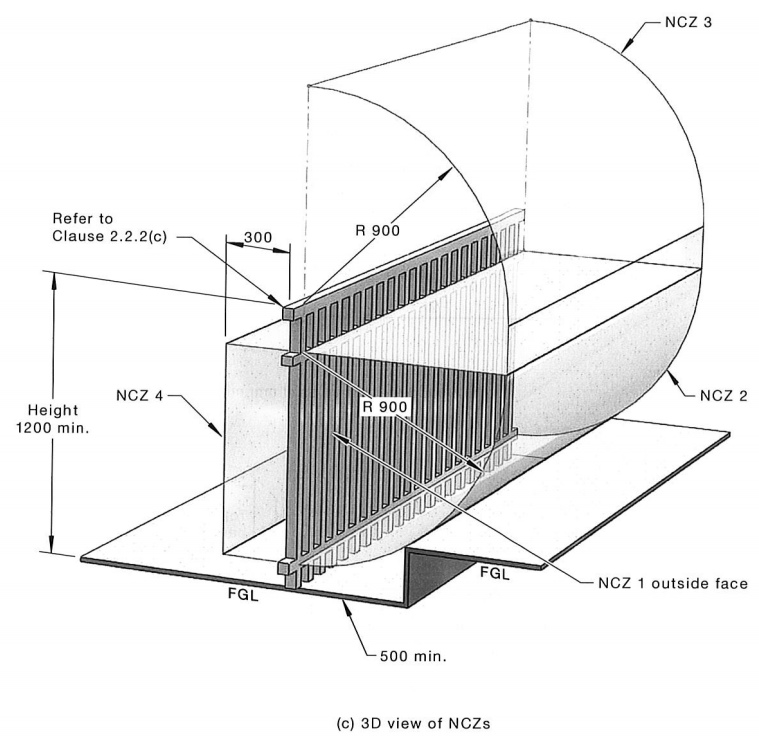Information
-
Address
-
Inspection Requested by
-
Date of Inspection
-
BA/DA/CDC No.
-
Parcel Number
-
Type of Pool
-
Owner name
-
Email
-
Contact Phone Number
Barrier - General
-
Does the barrier separate the pool from any residential building or place adjoining the premises?
-
Note: Residential building is defined by the Act:
"residential building means a building (such as a dwelling-house, residential flat building or boarding-house) that is solely or principally used for residential purposes, and includes any structure (such as a garage or shed) that is ancillary to any such building, but does not include:
(a) a building that merely forms part of a complex of buildings (such as a school or recreational centre) that is principally used for non-residential purposes, or
(b) a moveable dwelling, or
(b1) tourist and visitor accommodation, or
(c) a shed that is ancillary to a swimming pool and the primary purpose of which is to store equipment that is used in connection with the swimming pool (but not a shed of a kind prescribed by the regulations), or
(d) a building or structure of a kind prescribed by the regulations." -
WINDOWS opening into pool area restricted?<br><br>If sill is <1800 from ground, window must be either:<br>covered by bars or metal screen. Openings in bars or screen must not be >100mm and must require the use of a tool to remove<br>OR<br>Fixed so it cannot be opened any more than 100mm without the use of a tool
-
Is the barrier a permanent structure?
-
No features or objects that would reduce the height of the barrier to be located within 500mm of the barrier.
-
Features diagram
Pool Barrier Fencing - Measurements
-
Is finished ground level a permanent stable surface?
-
Is the height of fence from top of fence to finished ground >1200mm (for non-boundary fence)?
-
Is the width of all vertical gaps <100mm (including gate)?
-
Is the gap between bottom of barrier and finished ground level no greater then 100mm (including gate)?
Pool Barrier Fencing <1800mm - NCZs
-
3D NCZ DIAGRAM
-
NCZ1 clear?<br>NCZ1 is measured vertically on outside face of barrier.<br>No handholds or footholds, or objects or plants that will facilitate climbing in NCZ.<br>No projections or indentations with horizontal surface >10mm.
-
NCZ2 clear?<br>NCZ2 is a quadrant measured the outside of the barrier created by 900mm radius down from the top of NCZ1.<br>No handholds or footholds, or objects or plants that will facilitate climbing in NCZ.<br><br>Note: NCZ2 is always immediately adjacent to NCZ1 on all barriers
-
NCZ3 clear?<br>NCZ3 is a quadrant on the outside of barrier created by a 900mm radius UP from the top of the barrier<br>No handholds or footholds, or objects or plants that will facilitate climbing<br><br>Note: If the top of NCZ1 is below the top of the barrier, NCZ3 extends vertically down to the top of NCZ1.<br>Note: NCZ3 does not apply to any item or component on, or that is part of, the barrier. NCZ3 is applicable only to the space created by the quadrant.
-
NCZ4 clear?<br>NCZ4 is a 900mm high by 300mm deep rectangular space on the inside of the barrier, aligning with NCZ1.<br>No handholds or footholds, or objects or plants that will facilitate climbing in the NCZ.<br><br>Note: Only applies where barrier has vertical openings 10mm - 100mm in width.<br><br>
Boundary Pool Barrier
-
NCZ5 diagram
-
No less than 1800mm, measured from inside the pool area?
-
NCZ5 clear?<br>NCZ5 is a quadrant of 900mm radius, measured down from the top of the inside of the boundary pool barrier<br>No handholds or footholds, or objects or plants that will facilitate climbing in NCZ.
-
Where internal pool barrier intersects into NCZ5, the top of internal barrier must: <br><br>- be less than 50mm and intersect at angle between 45 and 13 degrees,<br><br>OR<br><br>- continue at >1800mm for at least 900mm.
Gates
-
Is the gate kept securely closed?
-
Does gate swing away from pool area?
-
Does gate swing freely through its entire arc of operation? (i.e. cannot be wedged open)
-
Full arc of operation clear of any building or doorway?
-
Confirm overall height >1200mm (on outside of pool area)?
-
NCZs clear for the gate?
-
Maximum 100mm under closed gate?
-
Vertical spaces no more than 100mm?
-
Self-closing device closes the gate from any position, with a stationary start, without the application of a manual force and operates the latch?<br> latch<br>2. From approximately half-open<br>3. From fully open position<br>4. Apply 25kg weight to gate whilst open for 30 seconds. Remove weight and let gate close under own propulsion.
-
From fully open position?
-
From any position after a 25kg weight has been placed on the top rail or component, 100mm from the outer edge of the locking stile of the gate for 30 seconds and then removed?
-
From partially open positions
-
Lift gate upwards and pull downwards with a force of 250N.<br>The above movement of the gate must not:<br>1. Release the latch<br>2. unhinge the gate<br>3. increase gap under gate to >100mm
-
Latch shall not be able to:<br>1. be inadvertently adjusted during operation<br>2. Locked in the 'open' position<br>3. adjusted without use of tools
-
Release point for latch?<br>Either:<br>- No less than 1500mm from finished ground level,<br>OR<br>- On inside and protected by 450mm shield, so no gaps >10mm present.
-
From gate resting on latch position?
CPR signage:
-
Is there a warning notice (CPR Chart) erected?
-
Is the sign in a prominent position in the immediate vicinity of the swimming pool?
-
Is the sign clearly legible?
Recommendation
-
Compliance
-
Issue compliance certificate
-
Issue non compliance certificate
-
Public safety risk?
-
Show cause
-
Emergency direction
-
Additional Comments
Council Officer
-
Inspected By
-
Signature
















![(AS1926.1-2012) [Installed or modified after 1/05/2013] Swimming Pool Inspection (AS1926.1-2012) [Installed or modified after 1/05/2013] Swimming Pool Inspection](/media/c85b6984-cbe5-49b9-b988-5bcd0839707f)

